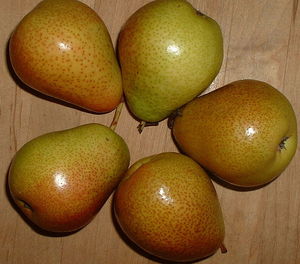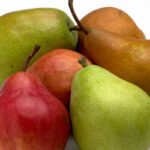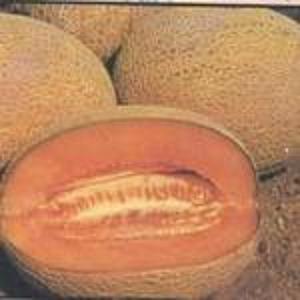Sweet, juicy, fun shaped pears are versatile and delicious raw or cooked. Pears found at your local grocery store were picked months prior and have spent the past few months in cold storage, so they are a few days from being ripe. Knowing this, and how to best ripen and use the fruit will help you get the most flavor and bang for your buck.
Pear Varieties
Bartlett pears are probably the most well known variety. With their wide, bulbous bottoms and long, thick neck, Bartletts have bright yellow, smooth skin with soft sweet flesh and are good for eating or baking.
Comice pears have wide bottoms and short, thick necks. If a Comice pear is soft, it’s overripe. This variety is best for eating or baking.
The Bosc pear looks almost identical to the Bartlett, except it has a thinner neck. Bosc pears have a dull skin color and very firm flesh even when fully ripe. This variety is best used for poaching.
D’Anjou pears have thin skins and an almost round shape. This variety has a creamy flesh which holds its shape well for poaching.
How to Ripen Pears
Determining if a pear is ripe can be tricky because a ripe pear does not change color and flesh remains firm. A ripe pear will have a slight give when you press a finger on the stem or blossom end. To speed up the ripening process, place pears in a brown paper bag along with one banana or apple. If you plan to poach pears, leave them a bit under ripe so they will retain their shape better.
How to Peel Pears
Use a vegetable peeler or sharp paring knife to peel away the skin and work downward from the stem.
As soon as it’s peel, rubbed pear with half a lemon of squeeze lemon juice on it to prevent browning.
Slice peeled pear in half and use a melon baller to remove seeds and the tip of a paring knife to cut away the gritty flesh around core and stem.
If you want to slice pears for eating, wait until you are ready to eat them before slicing to prevent browning. Lay pear half on cutting board, cut side down. Remove stem and blossom ends, then slice into quarter, wedges and into thinner slices as desired.
Serving Suggestions
Raw or poached are common (and delicious) ways to serve and eat pears, but also try them tucked inside sandwiches for a crisp burst of sweetness. Wrap prosciutto around pear wedges and serve as appetizers or fan out thin slices on a dessert plate, drizzle with honey and top with thinly sliced toasted almonds.








